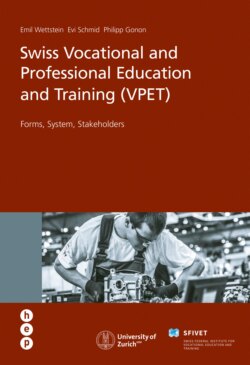Читать книгу Swiss Vocational and Professional Education and Training (VPET) - Philipp Gonon, Emil Wettstein - Страница 16
На сайте Литреса книга снята с продажи.
ОглавлениеPORTRAIT OF MAYBE SIMONS
Maybe Simons, 19,
is doing a VET programme at a public trade school
clear
One school? Fifteen workshops!
Most learners complete their VET programme in the triangle of host company, vocational school and branch course. There is a special form of VET in Biel.
It is a puzzle – it looks like a school but the classrooms are workshops. The products which are made here are generally not sold, and instead of a wage there are 13 weeks of holidays. Difficult? On the other side of the River Saâne people understand more quickly – trade schools (i.e. full-time vocational schools) are widespread in particular in the French-speaking part of Switzerland.
One such trade school is the Lycée technique (Technical College) in Biel which, in organisational terms, belongs to the Berufsbildungszentrum BBZ (Vocational Training Centre). It is located in a building in which General Motors assembled cars until 1975 – a three-storey building which houses 15 workshops with state-of-the-art equipment. Here, 200 young adults learn one of six technical professions, for example Microtechnology Draughtswoman, Federal VET Diploma (Mikrozeichnerin EFZ) or Electronics Engineer, Federal VET Diploma (Elektroniker EFZ); the technical Federal Vocational Baccalaureate is also offered. On the second floor, in Workshop 205, are the learners of the VET programme Watch Technician, Federal VET Certificate (Uhrenarbeiter/in EBA), a two-year apprenticeship which the Lycée technique offers only in French. One of the learners is Maybe Simons. She is in her second apprenticeship year.
Right now Maybe Simons is working on the vice of her workbench. With great concentration she uses a file to adjust the plate of a watch, sometimes she uses the jigsaw: “I am changing the plate and bridge according to my own ideas,” she explains. “In the end I can keep the watch – a piece of work that nobody else in the world will have!” The 19-year-old has only been working on this project for a few days, it is her reward for her good performance. Maybe Simons today already masters the most important techniques of her profession and is able to assemble three mechanical and quartz watches each with around 50 individual parts entirely by herself.
“At the trade school I can always practise new work steps,” she explains. “If I did my apprenticeship in a company, I would have to make series models more often.”
How serial work feels is something which Maybe Simons experiences in the traineeship which she attends for one day per week outside the trade school. Here, she becomes familiar with the production processes and the pace of a competitive company. All learners attend such traineeships during the entire training period. “Even if there is no regulated training in these companies, we are in contact with them and exchange observations about the skills and behaviour of the learners,” explains apprenticeship trainer Philipp Wittwer. Another learning location in the training of Maybe Simons is the one-month branch course in the first apprenticeship year. Learners from dual-track VET programmes also participated in this. The topic: metalworking. “If I did a three-year apprenticeship as a watchmaking practitioner, I would work on this theme for 25 to 30 weeks. Then I could turn and repair metallic parts,” explains Maybe Simons.
Apart from Maybe Simons, there are six other learners in the second apprenticeship year. To train them at the same time requires special facilities. That is why there are also screens on the workbenches. Here, the responsible apprenticeship trainer demonstrates individual work steps via camera. Another equally modern feature is a microscope with double eyepiece which enables the teacher to instruct learners individually. Weekly practical tests show how well they have paid attention. A trade school also makes specific demands in pedagogical terms – because the learners are a large group and there are no older learners, it is often difficult to get them to concentrate, as Philipp Wittwer explains: “Work on the social skills of the young people is part of our job.”
In a few months, Maybe Simons will undergo the qualification procedure. Her chances on the labour market are very good, says Philipp Wittwer. Maybe Simons might also want to continue her education. The possibility of doing this is provided, for example, by evening courses which lead to the Federal VET Diploma. During the day she could have a regular job – and earn her first real wage.
